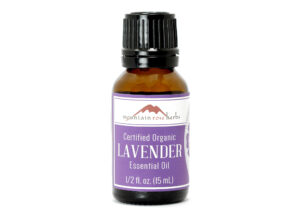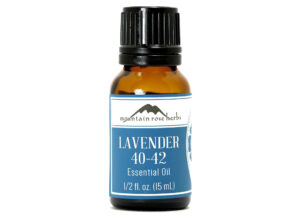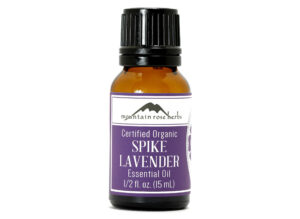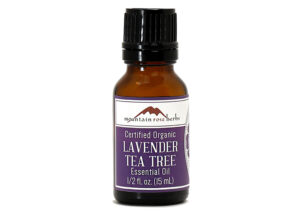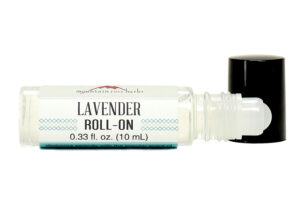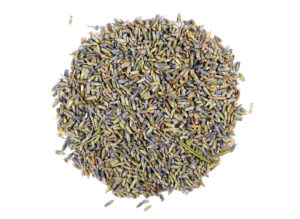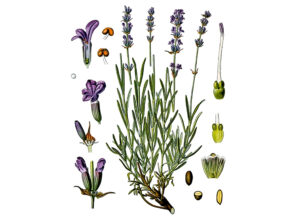Organic Lavender Essential Oil
Organic lavender essential oil is steam distilled from the blooms of the lavender plant. This perennial herb is native to the Mediterranean region, but is currently grown world-wide. It is prized for its heady, sweet fragrance and many healing properties. It has been used in cosmetics and as an herbal remedy to treat a host of conditions since ancient times. The ancient Egyptians used lavender in preparing their dead for the afterlife, while the ancient Romans used lavender to scent the public baths. The name lavender is thought to have come from the Roman word lavare meaning “to wash”.
What are the health benefits of organic lavender essential oil?
Lavender is best known for its ability to calm the nerves and induce restful sleep, but it has other health benefits as well. Some of the most common uses for lavender essential oil include:
- Relieves Headaches and Migraines -The fragrance is thought to relieve headaches and migraines. It may be inhaled or applied to the skin.
- Reduces Anxiety – Inhaling the fragrance of lavender oil is relaxing and calming.
- Alleviates Insomnia – Lavender sachets are often placed in bedrooms.
- Relieves Depression – The scent of lavender is thought to elevate and enhance mood.
- Treats Acne – Topical application of lavender oil prevents infection and may reduce sebum production.
- Heal Scars – Topical application rejuvenates tissues and speeds healing.
- Relieves Sore Muscles and Backache – The fragrance of lavender soothes muscle pains and aches and reduces the perception of pain.
- Improves Digestion – Lavender is thought to ease digestive disorders.
- Treats Wounds, Cuts an Abrasions – Lavender oil applied to open sores and wounds prevents infection and speeds healing.
- Treat Skin Disorders –Lavender essential oil is thought to soothe dry skin and promote healing in skin conditions like eczema.
Is there any scientific evidence to support the health benefits of lavender essential oil?
Yes. There have been a number of studies that support the health benefits of lavender essential oil.
A 2006 study at the New York University Medical Study concluded that inhaling the fragrance of lavender essential oil was effective in relieving post operative pain.
A 2009 study published in the journal Holistic Nursing Practice confirmed that lavender essential oil reduced test-taking anxiety in nursing graduate students.
Lavender: The Genus Lavandula , a compilation of the research on lavender, lists the following properties of lavender.
- Sedative: Lavender essential oil works to relax the body and promote sleep.
- Anti-anxiety: Lavender essential oil reduces stress and anxiety.
- Anti-Bacterial: Lavender essential oil kills bacteria responsible for infections or food poisoning.
- Anti-Fungal: Lavender essential oil prevents and treats fungal infections.
- Elevates Mood: People who inhale the fragrance of lavender essential oil report feeling happier.
How is lavender essential oil used?
Lavender essential oil can be used topically, in aromatherapy and taken internally. It is often used as fragrance in candles and potpourri and can be used in cosmetics, such as skin and hair care products, lotions and other beauty products. Lavender can also be used in cooking and in making tea.
Buy Organic Lavender Essential Oil
Organic lavender essential oil is a middle note steam distilled from the flowers of Lavandula angustifolia. One of our most popular essential oils, lavender oil has an unmistakable sweet, floral and herbal aroma found in body care and perfumes.
The name “lavender” is derived from the Latin lavare, meaning, “to wash”. Greeks and Romans perfumed their bathwater with lavender, burned lavender incense to appease their wrathful gods, and believed the scent of lavender to be soothing to untamed lions and tigers. Blends well with bergamot, peppermint, mandarin, vetiver, or tea tree.
Blends Well With
Bergamot, black pepper, cedarwood, chamomile, clary sage, clove, cypress, eucalyptus, geranium, grapefruit, juniper, lemon, lemongrass, mandarin, marjoram, oakmoss, palmarosa, patchouli, peppermint, pine, rose, rosemary, tea tree, thyme, and vetiver
Packaging
1/2 oz. and 1 oz. essential oils are packaged in amber glass bottles with drop reducers for easy application. Larger sizes are packaged in amber screw cap bottles and do not come with reducers or droppers.
Precautions
This oil can cause skin sensitization. Never use essential oils undiluted, in eyes or mucus membranes. Do not take internally unless working with a qualified and expert practitioner. Keep away from children.
Before using topically, perform a small patch test on your inner forearm or back by applying a small quantity of diluted essential oil and apply a bandage. Wash the area if you experience any irritation. If no irritation occurs after 48 hours it is safe to use on your skin.
Buy Lavender 40-42 Essential Oil
Lavender (40-42) essential oil is steam distilled from the flowers of Lavandula spp. This middle note is standardized to have a consistent aroma that is typically used in perfume, soap and candles. To standardize this oil, natural linalool and linalyl acetate are added to the blend to create an aroma that is the same every time. Lavender40-42 oil has a fresh and floral aroma that blends well with eucalyptus, armoise, marjoram, or rosemary.
Blends Well With
Bergamot, black pepper, cedarwood, chamomile, clary sage, clove, cypress, eucalyptus, geranium, grapefruit, juniper, lemon, lemongrass, mandarin, marjoram, oakmoss, palmarosa, patchouli, peppermint, pine, rose, rosemary, tea tree, thyme, vetiver
Packaging
1/2 oz. and 1 oz. essential oils are packaged in amber glass bottles with drop reducers for easy application. Larger sizes are packaged in amber screw cap bottles and do not come with reducers or droppers.
Precautions
This oil can cause skin sensitization. Never use essential oils undiluted, in eyes or mucus membranes. Do not take internally unless working with a qualified and expert practitioner. Keep away from children.
Before using topically, perform a small patch test on your inner forearm or back by applying a small quantity of diluted essential oil and apply a bandage. Wash the area if you experience any irritation. If no irritation occurs after 48 hours it is safe to use on your skin.
Buy Organic Lavender, Spike Essential Oil
Organic spike lavender oil is a middle note steam distilled from the flowering tops of Lavandula latifolia. Spike lavender essential oil has a spicier aroma than other lavender oils with warm floral notes. Spike lavender grows naturally at low altitudes, and true lavender grows naturally at high altitudes. This difference in growing conditions accounts for the camphor that is found in spike lavender and not in the other. Where the growing conditions of these two types of lavender meet, you can find a wide variety of lavender hybrids.
The oil and plant of spike lavender are used in similar ways to Lavandula angustifolia or true lavender. Spike lavender oil is also used throughout the fragrance industry: specifically soap making. Popular in perfumery, it blends well with clove, eucalyptus, patchouli, petitgrain, or cedarwood.
Blends Well With
Cedarwood, clary sage, clove, eucalyptus, lavender, oakmoss, patchouli, petitgrain, pine, rosemary, and sage
Packaging
1/2 oz. and 1 oz. essential oils are packaged in amber glass bottles with drop reducers for easy application. Larger sizes are packaged in amber screw cap bottles and do not come with reducers or droppers.
Precautions
This oil may be mildly neurotoxic based on camphor content. Never use essential oils undiluted, in eyes or mucus membranes. Do not take internally unless working with a qualified and expert practitioner. Keep away from children.
Before using topically, perform a small patch test on your inner forearm or back by applying a small quantity of diluted essential oil and apply a bandage. Wash the area if you experience any irritation. If no irritation occurs after 48 hours it is safe to use on your skin.
Buy Organic Tea Tree, Lavender Essential Oil
Our organic lavender tea tree essential oil is a top note steam distilled from the leaves of Melaleuca ericifolia, also known as rosalina. Lavender tea tree oil is related to the more well-known tea tree essential oil, but has a softer floral aroma with bright citrus notes.
Though the name sounds like a blend of two oils, in fact it is a single plant in the myrtle family. Other common names include rosalina and swamp paperback tree. Our lavender tea tree oil is both calm and uplifting for your state of mind. The floral notes in this aroma make this oil softer and more gentle than traditional tea tree essential oil. Lavender tea tree oil makes a great alternative to the stronger tea tree essential oil.
Blends Well With
Blue tansy, cedarwood, geranium, grapefruit, lavender, lemon, mandarin, sweet marjoram, and tea tree
Packaging
1/2 oz. and 1 oz. essential oils are packaged in amber glass bottles with drop reducers for easy application. Larger sizes are packaged in amber screw cap bottles and do not come with reducers or droppers.
Precautions
This oil has no known precautions. Never use essential oils undiluted, in eyes or mucus membranes. Do not take internally unless working with a qualified and expert practitioner. Keep away from children.
Before using topically, perform a small patch test on your inner forearm or back by applying a small quantity of diluted essential oil and apply a bandage. Wash the area if you experience any irritation. If no irritation occurs after 48 hours it is safe to use on your skin.
Buy Organic Lavender Roll-On
One of the most well-known essential oils in aromatherapy, lavender oil is a true classic. Herbaceously floral and calming, with light camphor notes, the intoxicating scent of lavender is pleasing to just about everyone. Our roll-on lavender oil blend is created in small batches and ready for use in a skin-safe 2% dilution.
The organic fractionated coconut MCT oil base is a clear and odorless carrier oil that absorbs completely without leaving an oily feeling. Roll lavender oil directly onto temples or under your nose to welcome serenity and calm any time or use directly on minor skin irritations.
The lavender oil used in our blend is distilled from organic Lavandula angustifolia flowers, also known as English lavender, common lavender, and true lavender. There is a long-documented history of lavender use dating back to ancient Egypt, Greece, and Rome with the use of the oil being well documented for over 2300 years!
Ingredients
Organic fractionated coconut MCT oil and organic lavender essential oil.
Buy Organic Lavender Flowers, English
English lavender, or Lavandula angustifolia, is not actually native to England but to the Mediterranean. Lavender flower is a favorite for its sweet, relaxing, floral aroma, and the flowers and leaves have a long history of use in traditional western herbalism. Dried lavender flowers can be added to potpourri blends, used as a cooking or baking spice, and incorporated into body care recipes.
For years we have sold both Lavandula angustifolia and Lavandula x intermedia as Lavender flowers. We are now excited to be able to offer you both of these beautiful flowers. In general, they can be used interchangeably; however some people do prefer one over the other.
Lavandula angustifolia is the classic lavender that most people are familiar with. It can also be found on the market as Common Lavender, French Lavender (when it comes from France), True Lavender, or Lavender. You may also see it labeled as Lavandula officinalis. This little greyish purple flower is known for its sweet floral aroma. The genus Lavandula is in the mint family.
Lavender is an aromatic perennial evergreen shrub. Its woody stems bear lavender or purple flowers from late spring to early autumn, although there are varieties with blossoms of white or pink. Lavender is native to the Mediterranean, but now cultivated in cool-winter, dry-summer areas in Europe and the Western United States. The use of Lavender goes back thousands of years, with the first recorded uses by the Egyptians during the mummification process. Both the Greeks and the Romans had many uses for it, the most popular being for bathing, cooking, and as an ingredient in perfume. Lavender was used as an after-bath perfume by the Romans, who gave the herb its name from the Latin lavare, to wash. During the Great Plague of 1665, grave robbers would wash their hands in a concoction called Four Thieves Vinegar, which contained lavender, wormwood, rue, sage, mint, and rosemary, and vinegar; they rarely became infected. English folklore tells that a mixture of lavender, mugwort, chamomile, and rose petals will attract sprites, fairies, brownies, and elves.
As a spice, lavender is best known as an important aspect of French cuisine and is an integral ingredient in herbs de Provence seasoning blends. Lavender may be used on its own to give a delightful, floral flavor to desserts, meats, and breads. The flowers can also be layered within sugar to infuse it with its distinctive aroma for use in cookies and candies.
Similar to cilantro, some individuals perceive the taste of lavender in a manner that is undesirable within cuisine. An estimated 10% of the population interprets lavender to have a soapy and unsavory flavor. For this reason, it may be wise to exercise caution while using lavender as a flavoring agent.
Lavender has been thought for centuries to arouse passions as an aphrodisiac and is still one of the most recognized scents in the world.
Precautions
No known precautions. We recommend that you consult with a qualified healthcare practitioner before using herbal products, particularly if you are pregnant, nursing, or on any medications.
Buy Organic Lavender Seeds
This munstead variety of L. angustifolia is a northern-hardy dwarf strain of English lavender that bears thick racemes of blue flowers. This variety is preferred by landscapers because of its compact form, cold-hardiness, heat tolerance, and great longevity. The plant prefers full sun and a dry to mesic, well-drained soil. The seed is very hard, and will benefit from a brisk sandpaper stratification, followed by sowing on sandy soil in the light. Keep moist until germination, which can take four to six weeks. Once the seedlings gain a healthy size, transplant to quarts. Grow for a few weeks, then transplant again up to gallons, always freeing the roots at transplant and using a rich but fast-draining mix. When transplanting out into the garden, space plants two to three feet apart.


